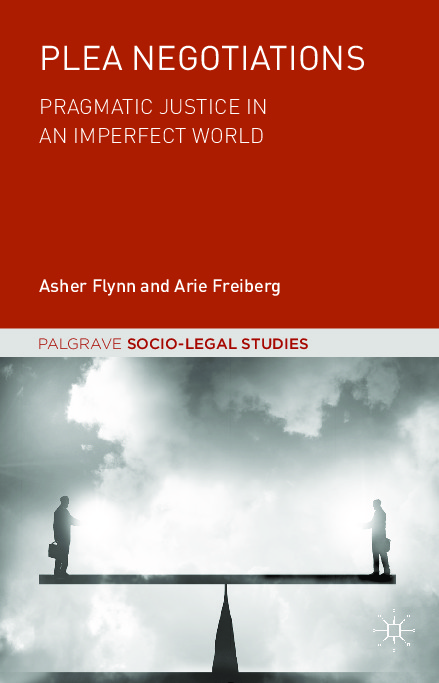File #2359: "2018_Book_PleaNegotiations.pdf"
Text
1|Dedication|6
1|Foreword|7
1|Acknowledgements|10
1|Contents|12
1|List of Abbreviations|14
1|List of Figures|16
1|1: Introduction|17
2|This Book|26
2|A Brief Note on Methodology21|27
2|Chapter Overview|29
1|2: Plea Negotiations in Context|33
2|The Victorian Prosecution Process|35
2|Negotiating Guilty Pleas in Victoria|40
2|The Case Files: An Overview|42
2|Overview of Defendants and Victims|43
2|Overview of Cases|46
1|3: Defining Plea Negotiations|53
2|Plea Negotiations Versus Plea Bargaining?|53
2|Most Common Forms of Negotiation|56
3|Withdrawing and Substituting Charges|57
3|Rolled-Up Charges and Representative Counts|62
4|Taking Offences into Account|66
3|Negotiating the Facts|67
3|Agreements on the Prosecutor’s Sentencing Submission|73
1|4: Other Forms of Negotiations|84
2|Agreement to Change Jurisdiction|85
2|Defendant to Provide Information on Another Matter|88
2|Agreement Not to Pursue Charges Against Another Person Known to the Defendant|91
2|Agreement Not to Pursue Other Charges/Investigations into the Defendant|93
2|Providing the Defendant and/or Their Family with Protection and/or Financial Support|95
2|Bail as a Point of Negotiation|96
2|Agreement to Recommend a Diversion|97
2|Agreement Not to Seek Costs|99
1|5: The Negotiation Process|102
2|Initiating Negotiations|102
2|Timing of Negotiations|104
2|Frequency of Negotiations|106
2|The Negotiation|107
2|Involvement of the Defendant|111
2|Approval Sought|111
2|Benefits of Negotiations|112
2|Key Considerations|113
3|Strength of the Evidence|114
3|Public Interest|114
3|The Client’s Interests|115
3|Personalities|117
2|Factors Shaping the Negotiation Process|122
3|Overcharging: The “Hamburger with the Lot”?|122
4|Statutory Charging Process|128
2|Summary Versus Indictable Offences|129
3|Contest Mentions and Summary Case Conferences19|134
3|Resources and Funding|136
3|Magistrates|139
2|Early Resolution Culture at the OPP|140
1|6: Negotiation Outcomes|146
2|Most Common Offences Negotiated|147
2|Difficult Offences|149
2|Family Violence|155
1|7: Plea Negotiations and Sentencing|161
2|Mandatory and Presumptive Sentencing|161
2|Sentence Indications|168
3|The Higher Courts|168
3|The Magistrates’ Court|173
4|Beneficial for Defendants|174
4|Beneficial for Defence Practitioners|175
4|Beneficial for the Courts|176
3|Limitations|176
2|Prosecution Submissions on Sentencing|179
2|Section 6AAA|188
1|8: Pragmatic Justice: At Any Cost?|198
2|Pressured Guilty Pleas|200
2|Legal Aid Funding and the Unrepresented Defendant|205
2|Mental Illness|211
1|9: Building Trust and Confidence in the Criminal Justice System|220
2|Interactive Plea Negotiation Scenario|229
2|Factsheets|231
1|10: Concluding Comments|234
1|Appendix 1|242
2|Policy of the Director of Public Prosecutions for Victoria: Chapter 4—Resolution|242
3|Introduction|242
3|Why Is Resolution Important?|242
3|When May Resolution Occur?|243
3|When Must the Solicitor Try to Reach Resolution?|243
3|When Must the Solicitor Seek the Views of the Victims and Informant About Resolution?|244
3|Resolution Requires CP or DPP Approval|244
3|Consent Mental Impairment Requires CP or DPP Approval|244
3|CPs and Solicitors Must Not Discuss Resolution with an Accused’s Legal Representative Unless Conducting the Prosecution|245
3|Resolution Must Be Reduced to Writing|245
3|Unrepresented Accused|245
1|Appendix 2|246
2|Methodology|246
3|Phase One|246
3|Phase Two|250
3|Phase Three|252
1|Glossary|254
1|References|257
2|Cases|257
2|Legislation and Policy|258
2|References|259
1|Index|276
1|Foreword|7
1|Acknowledgements|10
1|Contents|12
1|List of Abbreviations|14
1|List of Figures|16
1|1: Introduction|17
2|This Book|26
2|A Brief Note on Methodology21|27
2|Chapter Overview|29
1|2: Plea Negotiations in Context|33
2|The Victorian Prosecution Process|35
2|Negotiating Guilty Pleas in Victoria|40
2|The Case Files: An Overview|42
2|Overview of Defendants and Victims|43
2|Overview of Cases|46
1|3: Defining Plea Negotiations|53
2|Plea Negotiations Versus Plea Bargaining?|53
2|Most Common Forms of Negotiation|56
3|Withdrawing and Substituting Charges|57
3|Rolled-Up Charges and Representative Counts|62
4|Taking Offences into Account|66
3|Negotiating the Facts|67
3|Agreements on the Prosecutor’s Sentencing Submission|73
1|4: Other Forms of Negotiations|84
2|Agreement to Change Jurisdiction|85
2|Defendant to Provide Information on Another Matter|88
2|Agreement Not to Pursue Charges Against Another Person Known to the Defendant|91
2|Agreement Not to Pursue Other Charges/Investigations into the Defendant|93
2|Providing the Defendant and/or Their Family with Protection and/or Financial Support|95
2|Bail as a Point of Negotiation|96
2|Agreement to Recommend a Diversion|97
2|Agreement Not to Seek Costs|99
1|5: The Negotiation Process|102
2|Initiating Negotiations|102
2|Timing of Negotiations|104
2|Frequency of Negotiations|106
2|The Negotiation|107
2|Involvement of the Defendant|111
2|Approval Sought|111
2|Benefits of Negotiations|112
2|Key Considerations|113
3|Strength of the Evidence|114
3|Public Interest|114
3|The Client’s Interests|115
3|Personalities|117
2|Factors Shaping the Negotiation Process|122
3|Overcharging: The “Hamburger with the Lot”?|122
4|Statutory Charging Process|128
2|Summary Versus Indictable Offences|129
3|Contest Mentions and Summary Case Conferences19|134
3|Resources and Funding|136
3|Magistrates|139
2|Early Resolution Culture at the OPP|140
1|6: Negotiation Outcomes|146
2|Most Common Offences Negotiated|147
2|Difficult Offences|149
2|Family Violence|155
1|7: Plea Negotiations and Sentencing|161
2|Mandatory and Presumptive Sentencing|161
2|Sentence Indications|168
3|The Higher Courts|168
3|The Magistrates’ Court|173
4|Beneficial for Defendants|174
4|Beneficial for Defence Practitioners|175
4|Beneficial for the Courts|176
3|Limitations|176
2|Prosecution Submissions on Sentencing|179
2|Section 6AAA|188
1|8: Pragmatic Justice: At Any Cost?|198
2|Pressured Guilty Pleas|200
2|Legal Aid Funding and the Unrepresented Defendant|205
2|Mental Illness|211
1|9: Building Trust and Confidence in the Criminal Justice System|220
2|Interactive Plea Negotiation Scenario|229
2|Factsheets|231
1|10: Concluding Comments|234
1|Appendix 1|242
2|Policy of the Director of Public Prosecutions for Victoria: Chapter 4—Resolution|242
3|Introduction|242
3|Why Is Resolution Important?|242
3|When May Resolution Occur?|243
3|When Must the Solicitor Try to Reach Resolution?|243
3|When Must the Solicitor Seek the Views of the Victims and Informant About Resolution?|244
3|Resolution Requires CP or DPP Approval|244
3|Consent Mental Impairment Requires CP or DPP Approval|244
3|CPs and Solicitors Must Not Discuss Resolution with an Accused’s Legal Representative Unless Conducting the Prosecution|245
3|Resolution Must Be Reduced to Writing|245
3|Unrepresented Accused|245
1|Appendix 2|246
2|Methodology|246
3|Phase One|246
3|Phase Two|250
3|Phase Three|252
1|Glossary|254
1|References|257
2|Cases|257
2|Legislation and Policy|258
2|References|259
1|Index|276

